
Pu'er or stored tea
Sooner or later, as a tea enthusiast, you have to try pu'er, it's just so.... Whether you've heard of it before or not doesn't really matter, but it's a world of flavors all its own. Most varieties are pure, but there are actually some flavored pu'er teas.
Pu'er is actually the name of a city and county in Yunnan province in southern China. It has a long tea tradition, and is where the process of storing tea comes from. Many teas are tried to be drunk soon after harvest, but pu'er is unlike any other tea. There are two main types of pu'er, sheng which is also called "raw", "uncooked" or green pu'er. It has been allowed to mature slowly, and if it is of good quality, it gets better with time. The other type shou, "cooked" or dark pu'er has undergone a faster maturation process, and is somewhat similar to black tea.
What may be good to keep in mind is that raw/green pu'er should not be brewed in too hot water, otherwise it can become bitter.
Leaf or cake?
Pu's can come both as loose leaf, but even more often as cake. You can find some examples of cakes above. Loose leaf is easy to measure, but it can be a bit trickier with cake. If you have an accurate scale, it can of course be helpful. Otherwise, it's just a matter of trial and error.
If you're going to brew from a cake, you'll need to break off pieces from it first. Place the pu'er cake on a flat surface. Unfold the wrapping paper, so it can catch any small leaves that come loose. There are also trays specifically for this purpose. Use a pu'er knife or an awl to pry off pieces of the cake. Don't saw or file the tea leaves, keep them as whole as possible.
There are many traditions, but no one "right" way to brew. Try your hand at what you like, but here are some tips as a starting point.
Western brewing
You can brew pu'er the same way Europeans brew black tea:
- Place 1 tsp tea leaves/cup plus a spoon "for the pot" in a teapot
- Add hot water, around 85°C for green, and 100°C for dark.
- Let steep 2-3 minutes
- Strain and enjoy
You can also try brewing another batch on the same leaf. Depending on the dosage and exact temperature, it can be more or less successful.
Gong-fu brewing
In Chinese tradition, brewing is done according to the gong-fu method. Basically, it is about dosing more heavily, brewing for a short time, but therefore many brews on the same leaf. They like to use tiny teapotss, or small cups with lids, called gaiwan for brewing. Then you serve in cups that are so small they could fit in a doll's house.
A decent gaiwan holds maybe 1- 1½ deciliters. We're talking small!
Here's how it works:
- Preheat the teapot/gaiwan and cups with hot water
- Place 3-4 tsp of tea leaves, i.e. 6-8 grams/1 dl in the teapot or gaiwan.
- Add water, 85-100 °C depending on the variety, and let it steep for 5-10 seconds
- Pour away the first brew
- Add more water, but let it steep for about ½ minute
- Drain the gaiwan or pot into the small cups
- Sip the tea
- Go back to point 4, but be prepared to adjust the time slightly
.
Often this can be 5-10 brews or more.
Then you replace the leaves, and start again.
It can look a little stingy with cups that hold a tablespoon or so.
But after 10, 20 or 50 cups you'll be happy anyway. ....
